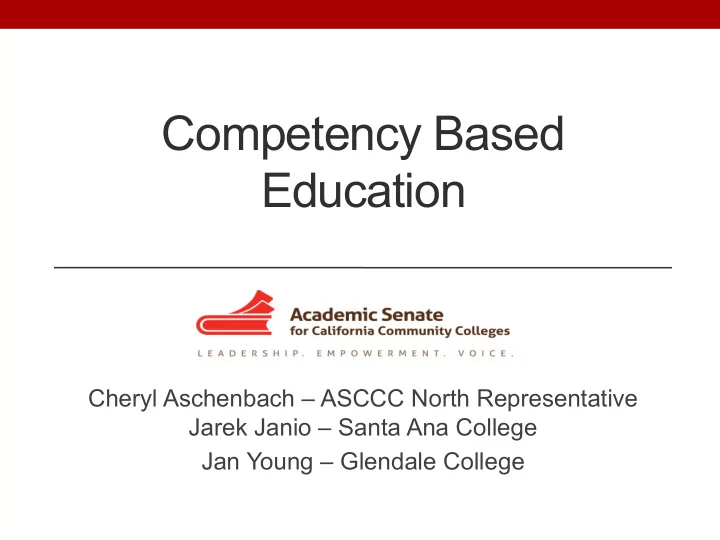

Competency Based Education Cheryl Aschenbach – ASCCC North Representative Jarek Janio – Santa Ana College Jan Young – Glendale College
Overview • What is competency based education (CBE)? • What does CBE look like in practice? • How can you consider CBE in your discipline?
Competency-Based Education The competency-based education (CBE) approach allows students to advance based on their ability to master a skill or competency at their own pace regardless of environment. This method is tailored to meet different learning abilities and can lead to more efficient student outcomes.
Competency-Based Education • Competency-based or Outcomes-based • Advancement based on mastery of outcomes rather than seat time or credit hours • Mastery demonstrated through assessments
Competency-Based Education • Changing paradigm: • Credit hour content mastery • Focus on teaching focus on learning • Time is constant/learning is variable time is variable/learning is constant • Greater focus on employer input regarding knowledge, skill, and aptitude (KSA) needs of future employees
Competency-Based Education • Colleges already do some CBE • Open entry/open exit courses in CTE and noncredit • Credit by Exam
Examples of CBE • Noncredit • Math and writing labs • Accounting (Glendale) Medical Front Office (Glendale) • High School Diploma classes (Glendale) • Keyboarding (Glendale) • CTE Certificates • Nursing • Welding • Noncredit pathways • Health Care Pathway: • Nursing Assistant • Medical Billing and Coding • Introduction to Medical Assistant • General Medical Office Clerk
Competency-Based Education Can more be done? • Can CBE be done in census classes? • Can more CTE education be CBE? • How can we accomplish this?
Implementing CBE • Identifying outcome competencies is key – all supporting learning objectives must be identified and sequenced within a program and courses • Objectives may be used rather than outcomes – usually require demonstration of more discrete skills or knowledge
Implementing CBE • Identify and reduce or eliminate ineffective structures, practices, and expectations that may have been historically justified but are now impeding the efficiency of student learning • Minimum hours & unit requirements • Minimum internship/externship hours requirements • Required skills practice regardless of current competence
Implementing CBE • Design classroom and lab experiences with pre- assessment opportunities • Based on outcomes or objectives, determine the appropriate assessment(s) and level of mastery • Pre-assessments may be the same as post-assessment, or the two may vary for greater demands on students • Pre-assessments may be integrated into early classroom activities or assignments rather than formalized as separate assessment opportunities • Instruction based on students learning, rather than faculty teaching. • Establish achievement benchmarks • Establish program exit criteria
QUESTIONS? THANK YOU! Cheryl Aschenbach: caschenbach@lassencollege.edu Jarek Janio: Janio_Jarek@sac.edu Jan Young: jyoung@glendale.edu info@asccc.org
Recommend
More recommend